Laminators have been popular for a while not. They are usually used to safeguard important documents. By sealing the edges of that document with some sort of nylon, it can be kept for years without any worry. While this is true, some people still have a lot of problems choosing between a hot and cold laminator.
So, this article will help you understand the difference between a hot and a cold plastifieuse. It will also look at the different times where it is appropriate to use them on a document. Read on to find the answers to your questions.
Understanding what a cold laminator is
Cold laminators are often used when the material in question is quite sensitive. For example, if you are dealing with a photo or a business card that is made from inkjet, then a cold laminator will be the best choice.
Another time when using a cold laminator will be very appropriate is if the material is sensitive to heat. Sometimes, using a hot laminator on sensitive materials can make the ink or any properties on the material melt. That defeats the whole purpose of lamination.
There are many reasons why people love the cold laminator. First, it doesn’t use heat. This means that it needs little or no electricity to function properly. There is also little or no chance that it will destroy your documents. With the cold laminator, things are a bit safer.
Understanding what a hot laminator does
These are the well-known laminator. They use heat to do most of the lamination processes. To make it work the temperatures used by the hot laminator will range between 100-300 degrees.
When using the hot laminator, it is important to use it only on materials that are known to be able to withstand high temperatures.
There are many reasons why people love to use the hot laminator. First, the hot laminator’s effect on documents is very durable. It can withstand wear and tear for years. This makes it the first choice for many people.
Where can you buy laminators?
Do you want to get laminators? Perhaps for personal or business use? Then you might want to try specific stores that sell laminators. However, there are some drawbacks to following this method. First, the prices will be a bit higher than usual. You might have to shop around to get the best prices on the products.
This might mean a lot of resources and precious time has gone. One of the best ways might be to hit online stores. They have a whole list of laminators to choose from. You can access these options with just a click. The offer prices are also quite affordable. You should really have no problems heading forward.
Conclusion
So there you have it. Buying a cold or hot laminator depends on the material that needs to be laminated. It also depends on what you are looking for. By doing the right research into the laminator, you can be sure you will make the right decision.

